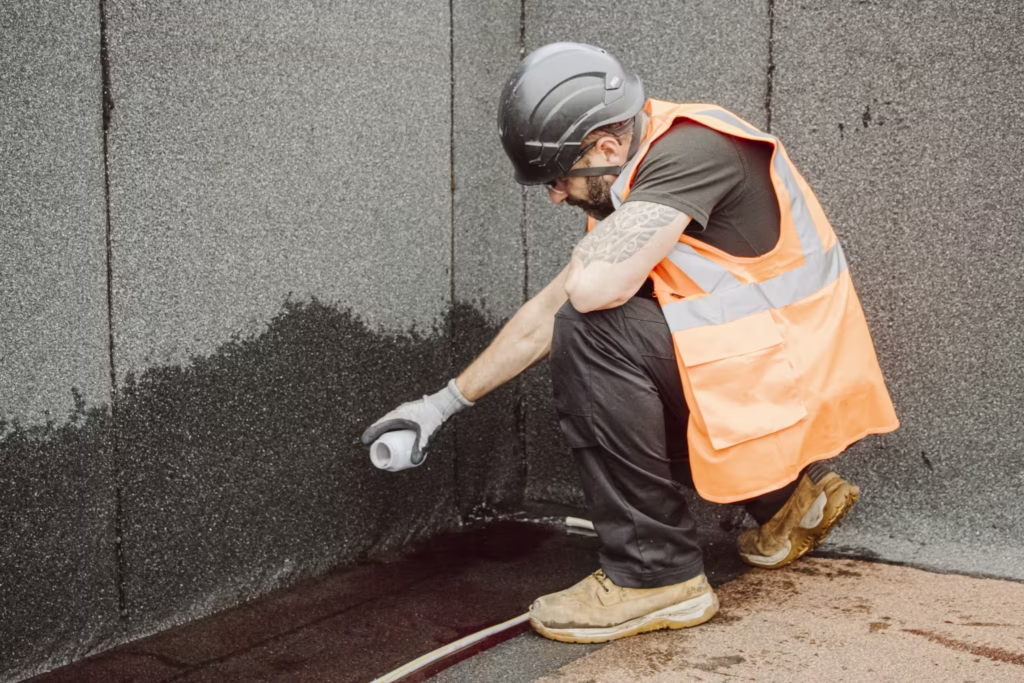When it comes to water ingress, a lot of buildings have fallen into the same trap: see the leak, stick a bucket under it, and hope it doesn’t get worse.
But leaks rarely fix themselves!
Left unchecked, they quietly erode internal finishes, compromise structures, and escalate into costly repairs, often just as your CEO or VIP guest notices a damp patch overhead…or worse, on their head!
We sat down with James Middleton, one of our senior project surveyors, to talk about why water leak investigations matter, why so many issues are left too long, and how a pro-active approach and the right expertise can make the difference between a minor repair and a major failure.
Why leaks are often ignored until they become critical
According to James, water ingress is “fairly common” across commercial buildings, but it’s also as commonly brushed aside.
“A lot of people see it as a minor inconvenience, until it’s not. It’ll be ignored in a stairwell or tucked-away corridor, but when it’s dripping into the CEO’s office, that’s when the phone rings.”
For hotels, the stakes are higher. Rooms left out of service mean lost revenue, sometimes for months at a time. Commercial offices, which can now be relatively empty on some days, tend to react once senior staff demand action, but leaks can go on for years before anyone tackles the root cause.
Ultimately, standing water and inaction is a problem. Every day of delay allows water to continue eroding finishes, spreading unseen throughout the ceilings and roofs, and worsening the eventual repair bill.
Warning signs building managers should never ignore
Early detection largely depends on maintenance discipline. James points out that simple practices, such as regular gutter clearance and external cleaning, make leaks easier to spot before they cause havoc inside.
Some of the visible warning signs he flags include:
- Damp patches or mould growth
- Internal staining or blistered paint
- Vegetation sprouting from gutters
- Ponding water on flat roofs
- Cracks and splits in membranes or sealants
- Blocked outlets
And the message is simple: if you wouldn’t ignore a hole in your ceiling at home, don’t ignore one in your building.
Why diagnosis is more complex than it looks
One of the biggest challenges with water ingress is that where you see the problem isn’t necessarily where it starts.
James explains: “A damp patch could be metres away from the actual source. Without the right investigation and methodologies, you end up fixing a problem, but not the problem.”
This is why quick patch repairs to obvious holes so often fail. They deal with a symptom, but not all of the sources. Weeks later, the leak is back.

What makes a professional water leak investigation different?
Visual checks alone can’t solve this. At Building Transformation, every investigation is built on a holistic, evidence-based approach.
James outlines the specialist tools his team uses to uncover the true source of ingress:
- Electronic leak detection – picks up pinholes invisible to the human eye.
- Thermal imaging – maps moisture movement and highlights hidden failures.
- Moisture meters – identify saturation beneath roof membranes.
- Gutter cameras and dye testing – track blockages, misflows, and drainage faults.
- Lap scribing – a simple tool that can uncover previously unseen failures and ingress points
Every investigation is followed by a clear photographic report, showing before-and-after evidence and a prioritised action plan.
Access expertise matters as much as diagnostics
Of course, finding the problem is only half the challenge. For tall and complex buildings, access can be a barrier in itself.
James stresses the importance of safe, efficient planning:
“We’re now ISO 45001 accredited, re-affirming our commitment to always reducing risk and ensuring a safe working environment for our teams. Our bespoke access methods and in particular our rope access teams mean that we can provide the most efficient way of reaching the problem and are far less costly and intrusive than scaffolding, and it allows us to efficiently investigate and repair at the same time.”
That ability to inspect and fix simultaneously minimises disruption and cuts costs for property managers who can’t afford extended downtime or disruption.
Why early intervention pays off
So why does it all matter? The risks of delay are clear:
- Escalating repair costs as issues worsen unseen
- Revenue loss from unusable space
- Compliance breaches and increased liabilities
- Reputational damage for buildings open to tenants or the public
- Increased chances of health and safety risks to building users
James has seen it too many times:
“Leaks can be ignored for five or ten years. Then suddenly there’s a VIP conference, and everyone’s holding their breath that it doesn’t rain. The truth is, if you’d invested in regular inspections, you’d have saved thousands and avoided the stress.”
Peace of mind through proactive inspections
The BS 6229 standard recommends biannual roof and façade inspections, once in autumn, once in spring. These inspections clear blockages before winter, and check for damage after storms, frost, and ice.
For facilities managers, partnering with Building Transformation means inspections are carried out to the highest industry standard. That way, you’ll have a clear, evidence-led report and the reassurance that your building envelope is safe, compliant, and under control.
Don’t leave it too late
Every leak tells a story. The question is whether you catch it early or wait until it becomes a costly emergency.
At Building Transformation, we combine rope access expertise, advanced diagnostics, and years of technical insight to find and fix leaks before they spiral out of control.